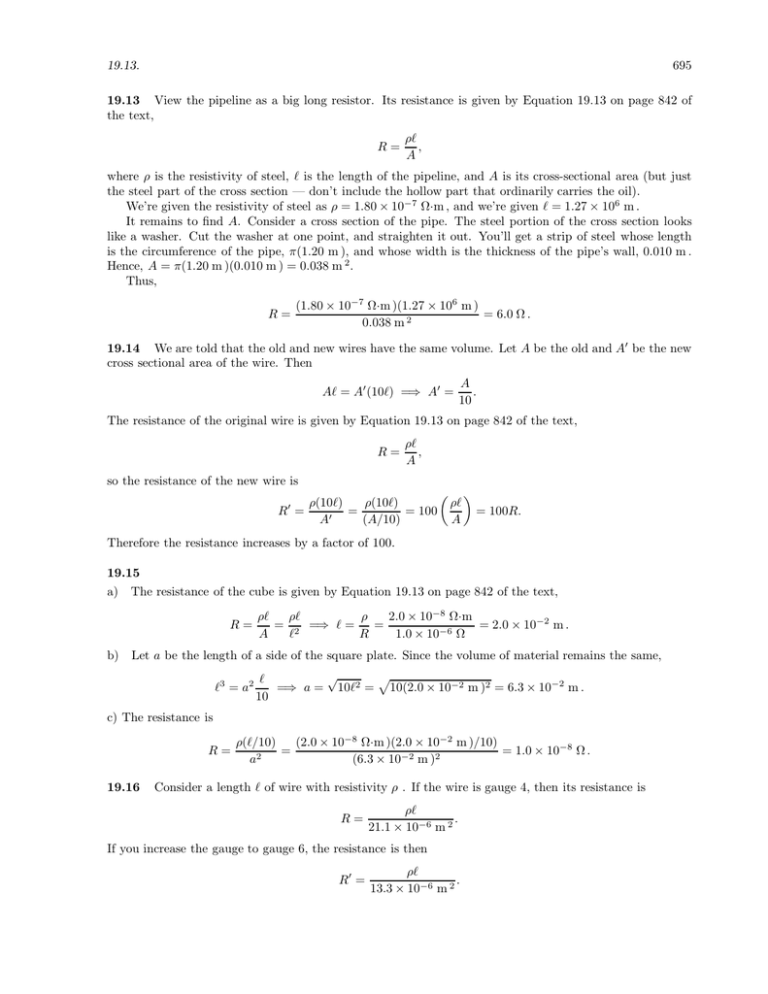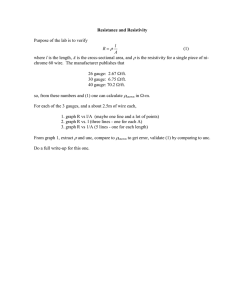19.13. 695 19.13 View the pipeline as a big long resistor. Its
advertisement

695 19.13. 19.13 View the pipeline as a big long resistor. Its resistance is given by Equation 19.13 on page 842 of the text, R= ρ` , A where ρ is the resistivity of steel, ` is the length of the pipeline, and A is its cross-sectional area (but just the steel part of the cross section — don’t include the hollow part that ordinarily carries the oil). We’re given the resistivity of steel as ρ = 1.80 × 10−7 Ω·m , and we’re given ` = 1.27 × 106 m . It remains to find A. Consider a cross section of the pipe. The steel portion of the cross section looks like a washer. Cut the washer at one point, and straighten it out. You’ll get a strip of steel whose length is the circumference of the pipe, π(1.20 m ), and whose width is the thickness of the pipe’s wall, 0.010 m . Hence, A = π(1.20 m )(0.010 m ) = 0.038 m 2 . Thus, R= (1.80 × 10−7 Ω·m )(1.27 × 106 m ) = 6.0 Ω . 0.038 m 2 19.14 We are told that the old and new wires have the same volume. Let A be the old and A0 be the new cross sectional area of the wire. Then A` = A0 (10`) =⇒ A0 = A . 10 The resistance of the original wire is given by Equation 19.13 on page 842 of the text, R= ρ` , A so the resistance of the new wire is R0 = ρ(10`) ρ(10`) = = 100 0 A (A/10) ρ` A = 100R. Therefore the resistance increases by a factor of 100. 19.15 a) The resistance of the cube is given by Equation 19.13 on page 842 of the text, R= b) ρ ρ` 2.0 × 10−8 Ω·m ρ` = 2 =⇒ ` = = = 2.0 × 10−2 m . A ` R 1.0 × 10−6 Ω Let a be the length of a side of the square plate. Since the volume of material remains the same, `3 = a2 √ p ` =⇒ a = 10`2 = 10(2.0 × 10−2 m )2 = 6.3 × 10−2 m . 10 c) The resistance is R= 19.16 (2.0 × 10−8 Ω·m )(2.0 × 10−2 m )/10) ρ(`/10) = = 1.0 × 10−8 Ω . a2 (6.3 × 10−2 m )2 Consider a length ` of wire with resistivity ρ . If the wire is gauge 4, then its resistance is R= ρ` . 21.1 × 10−6 m 2 If you increase the gauge to gauge 6, the resistance is then R0 = ρ` . 13.3 × 10−6 m 2 696 CHAPTER 19. ELECTRIC CURRENT, RESISTANCE, AND DC CIRCUIT ANALYSIS To find the factor by which the resistance increases, evaluate their ratio 21.1 × 10−6 m 2 R0 = ≈ 1.6. R 13.3 × 10−6 m 2 A similar result is obtained if you increase the gauge number by 2 with other initial gauge numbers. For example, if you increase the gauge from 6 to 8, the ratio of the resistances is 13.7 × 10−6 m 2 R0 ≈ 1.6, = R 8.37 × 10−6 m 2 so the result does not depend upon the gauge of the initial wire. 19.17 From Equation 19.3 on page 840 of the text, the current in the big wire is I = nqAhvi =⇒ hvi = I , nqA where n is the number of charge carriers per unit volume, q is the amount of charge per carrier, hvi is the 2 d , so drift speed, and A is the cross-sectional area. Let d be its diameter. Then A = π 2 hvi = 4I I . 2 = 2 nqπd d nqπ 2 d For the small wire, I, n, and q are the same, but the diameter is , so the cross-sectional area is A0 = π 2 Therefore its drift speed will be hv0 i = 2 d . 4 I 16I . 2 = nqπd2 d nqπ 4 The drift speed in the small wire is greater than that in the big wire by a factor of 4. 19.18 a) Use Equation 19.15 on page 845 of the text, ρ = ρ0 [1 + α(T − T0 )] =⇒ 0 Ω · m = ρ0 [1 + α(T − T0 )] =⇒ (T − T0 ) = − 1 1 = 2 × 103 K . =− α −0.5 × 10−3 K −1 If we take the reference temperature to be 20◦C= 293 K = T0 , then T = 2 × 103 K + 293 K = 2 × 103 K . b) The result of part a) is cooler than the melting temperature. It is unlikely that the resistance of diamond vanishes when the temperature is 2×103 K , which calls into question the assumption about the temperature independence of α.

